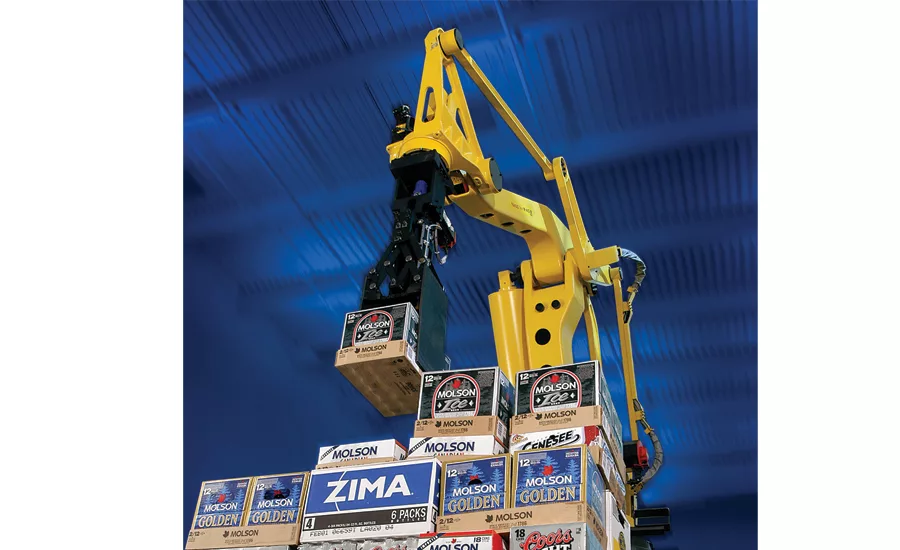Robotics technology transforms automation movement
Vision systems and gripping mechanisms more sophisticated

As prognosticators forecast a growing need for students with a love for STEM — the fields of science, technology, engineering and math — markets like robotics likely will reap the benefits from this emphasis. Whether its toys like Star Wars BB-8 or robots helping doctors perform surgery, the scissor-like precision and accuracy of robotics technology also is boosting efficiency and driving success in beverage plants worldwide.
Increasing efficiency, process optimization and ensuring a smooth, connected supply chain relies on automation, particularly as “smart” technology continues to advance with more sophisticated sensing, vision systems and gripping mechanisms playing a vital role in beverage operations, says Dean Terrell, senior vice president of development at Material Handling Systems Inc. (MHSI), Louisville, Ky.
“Key advances in technology, like sensing, vision systems and gripping mechanisms, have all come together for maximum effect, creating solutions that are more capable and versatile than ever before,” Terrell explains. “In practical terms, this allows robotics to make more complex decisions than ever before, like identifying which item to grab from a pile, determining how to do so and finally having the ability to actually grasp it.”
SKU proliferation and the abundance of different sizes and shapes of beverages and packaging types, for instance moving from rigid corrugated boxes to malleable polybags, poses new challenges for gripping technology, Terrell adds.
James Cooper, executive director of global accounts at FANUC America, points to growing consumer demand for innovation as a contributor to the growing use of robotics. “Beverage producers are facing an increasing demand from consumers for new flavors, innovative container design and increased use of variety packs,” he says. “All of these demands drive the need for flexibility, which robotics can provide. Additionally, robots are an ideal solution for the latest trend of lightweighting containers because they can be programmed with varying speeds and force to handle products more gently.”
The Rochester Hills, Minn.-based company notes that FANUC robots are evolving in speed, performance and in advanced integrated vision technology. With more than 24 million products installed worldwide, the company offers robotics, CNCs and ROBOMACHINEs with payload capabilities from 0.5 to 2,300 kg. that seamlessly work in eCommerce, food and beverage and other industries, Cooper says.
As operations in the beverage industry ramp up, Cooper notes an increased adoption of Industrial Internet of Things (IoT) technologies such as FANUC’s Zero Down Time (ZDT), which monitors the health of the robot and identifies when key parameters trend outside of acceptable working conditions. “The benefit to customers is that FANUC, using advanced algorithms, can predict key issues in advance so that downtime can be planned,” he says.
Experts also note a greater integration between data and robotics. “More companies are using data on orders, inventory, as well as captured data from robotic material handling systems (thanks to the Internet of Things), to find ways to guide or reorganize automation in real time,” says Derek Rickard, sales manager at Cimcorp Automation Ltd., Norcross, Ga. “This combination of data and robotics enables distribution centers to more readily accommodate changes and pivot as needed. They can also analyze the data to find ways to improve the flow of operations.”
Alan Spreckley, global food and beverage segment manager for Auburn Hills, Mich.-based ABB Robotics, further elaborates on the flexibility that industrial robots provide in beverage processing and warehousing as well as the more traditional areas of packing and palletizing.
With the upsurge of more flavors and packaging sizes in the beverage market, robotics offer warehouses an ideal solution for handling the “low volume, high mix of products, [which are] now the new normal,” Spreckley says.
Robotics also bring an ability to ensure consistent throughput on lines, improve yield, reduce waste and facilitate rapid changeovers while re-assigning employees to more rewarding jobs away from heavy and difficult operations, he adds.
Leveraging automation
Manufacturing robotics are fulfilling a need state in warehouse fulfillment centers for palletizing, depalletizing, picking and placing, and precisely moving products. The technology has no signs of abating, experts note.
“The food and beverage industry has increased its use of robotics and automation by 20 percent from 2014 to 2016,” says David Schwebel, vice present of business development and market intelligence at Swisslog Logistics, Newport News, Va. “Value-added services, such as customer-order-specific pallets, and reduced time to market and inventory costs have increased the demand for robotics in smaller distribution centers.
”… Consumers expect sustainable supply chains — this is improving quality and process excellence, which is in turn creating a nexus of opportunity for robots to augment and ultimately solve in the long term,” Schwebel continues.
There’s also been a 34 percent, or ten-fold, uptick in sales of collaborative robots, or “cobots,” says Stuart Shepherd, regional sales director of the Americas division at Universal Robots (UR) USA, Ann Arbor, Mich., citing the International Federation of Robotics.
Not confined to a cage or dedicated to only one task, cobots work hand-in-hand with operators on a wide range of tasks and increase opportunities for human-robot collaboration, Shepherd says.
He notes that the IIoT fostered the creation of UR’s new initiative UR+, an “app store” for robots that enables third-party developers to create certified plug-and-play products for the company’s cobots such as grippers, vision systems as well as monitoring software and hardware that send alerts and daily reports on productivity to a phone or laptop.
Connectivity and communication
Sensing and vision technology has led to safer, more reliable tools in the beverage warehouse. For instance, Greenville, N.C.-based Yale Materials Handling Corp.’s new robotic reach truck uses LiDAR-based technology to navigate through busy warehouse environments. “The robotic reach truck uses a 3-D camera system to help it locate and pick or place loads up to 30 feet high in double-deep storage racking,” says Mick McCormick, robotics business leader at Yale.
Matt Wicks, vice president of product development at Mason, Ohio-based Honeywell Intelligrated, emphasizes the competitive advantages that robotics and integrated software solutions bring to the table.
“Robotic case packing and unpacking solutions work at both ends of the production line, singulating bottles in preparation for filling, then loading product back into cases for end-of-line palletizing,” Wicks explains. “Sortation and picking systems designed specifically for beverage distributors work together with traditional conveyors to make shipping to restaurants, commercial kitchens and retail customers quick and efficient.”
Although robotics offer flexibility and improve productivity, UR’s Shepherd suggests the challenge is to “teach” robots to pick up different items that they never have handled before from an unstructured environment like a bin or tote. “This flexible grasping technology has been ‘the holy grail’ in robotics research,” Shepherd says. “It is now available in several innovative cobot-assisted new systems that combines an easy-to-program collaborative robot arm, computer-vision and machine-learning systems, and a gripper with sensor feedback.”
Experts note that robotic technology is being integrated into complete warehouse automation systems. For instance, distribution centers use FANUC robots to build rainbow and mixed load pallets, FANUC’s Cooper says.
MHSI’s Terrell agrees that order fulfillment and robotics’ ability to handle the monotonous task of precisely picking products from bulk piles allows the technology to shine. It also improves business continuity, accuracy and reduces costs, he adds.
Moving goods seamlessly
Within the past five years, robotics and automation is designed for “cut-ins/upfits” to existing warehouses. “For example, storage engines, automated storage retrieval systems, and conveyor and pick modules are designed with the ability to augment existing warehouse solutions,” Swisslog’s Schwebel explains. “‘Rip and replace’ is seen as both economically wasteful and financially unfeasible (as project ROIs timelines become too long to be obtainable with capital hurdle rates at 11 percent to 12 percent.)”
Augsburg, German-based KUKA, the parent company of Swisslog, recently developed a “ready for” line of robotic work cells that assist line-side manufacturing, in-process manufacturing, end-of-line palletization and the autonomous movement of goods, Schwebel says. “These popular robots are re-deployable,” he explains. “As manufacturing lines move, so do the robotic work cells. [These] autonomous mobile robots (AMR) reduce the ‘bolts in the ground’ that conveyors require.
“… Looking ahead, movable customer case pick work cells are one of the biggest things to come in robotics,” he continues. “Having a movable customer case building work cell improves the density and ebb and flow of distribution centers.”
Experts note the evolution of robotics will continue to grow as beverage manufacturers look for the next “big thing.”
“Everything will become more connected and intelligent thanks to data,” Cimpcorp’s Rickard says. “We will see the emergence of smart warehouses, where data, analytics and robotics come together to transform the movement of goods. In the smart warehouse, you have real-time data flowing between advanced robots and high-level software, creating a feedback loop so you can monitor, control and optimize product flow.”
Honeywell Intelligrated’s Wicks agrees: “I think we’re going to see some exciting applications for machine learning and AI [artificial intelligence], which we’re already implementing in solutions like our robotic unloader and sorter induction system. Robotics will be able to make more independent decisions and have the capacity to solve problems on the fly, even if they haven’t been programmed with a specific solution ahead of time.” BI
Looking for a reprint of this article?
From high-res PDFs to custom plaques, order your copy today!






